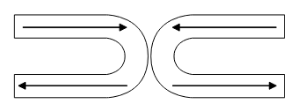
Two streams of water flow through the U-shaped tubes shown. The tube on the left has a cross-sectional area $A$ and the speed of the water flowing through it is $v$, the tube on the right has a cross-sectional area $A' = \dfrac{A}{2}$. If the net force on the tube assembly is zero. What must be the value $v'$ of the water flowing through the tube on the right? Neglect gravity and assume that the speed of the water in each tube is the same upon entry and exit.

A. $\dfrac{1}{2}v$
B. $v$
C. $\sqrt 2 v$
D. $2v$

Answer
489.3k+ views
Hint: We have two U-shaped tubes and the one on the right has a cross-sectional area half of that of the one on the left and we need to find the relation between the velocities of both the tubes. We need to calculate the change in momentum of both the tubes for finding the required relation.
Complete step by step answer:
Firstly for the tube on the left we have the rate of change of momentum given by
$\Delta p = m(v - ( - v))$
The initial velocity of the tube is in the positive direction and the final velocity will be in the negative direction. By solving the above equation we get
$\Delta p = 2mv = 2\rho {\rm A}{v^2}$
Since the rate of change of volume of a liquid is given by the product of the velocity of the liquid and its cross-sectional area. Similarly, for the tube at the right, we have the rate of change of momentum given by
$\Delta p' = m'( - v' - (v')) = - 2\rho A'v{'^2}$
We know that the rate change of momentum is equal to the force applied and it is given that the net force applied on the system is zero and therefore the force or the rate of change of momentum of the tube should be equal. Hence we have
$\Delta p = \Delta p'$
Substituting the values we get
$2\rho A{v^2} = 2\rho A'v{'^2}$
Substituting the value of the cross-sectional area of the right tube in terms of the cross-sectional of the left tube we get
$\rho A{v^2} = \rho \dfrac{A}{2}v{'^2}$
$\Rightarrow 2{v^2} = v{'^2}$
$\therefore v' = \sqrt 2 v$ which is the required relation.
Hence option C is the correct answer.
Note: The initial and the final velocity of a liquid in a U-shaped tube is given by the direction of the liquid entering the tube and direction of the liquid leaving the tube respectively and hence it is taken opposite. And since we have water flowing through the assembly given, we have taken the same densities for both the tubes while comparing since it has the same liquid.
Complete step by step answer:
Firstly for the tube on the left we have the rate of change of momentum given by
$\Delta p = m(v - ( - v))$
The initial velocity of the tube is in the positive direction and the final velocity will be in the negative direction. By solving the above equation we get
$\Delta p = 2mv = 2\rho {\rm A}{v^2}$
Since the rate of change of volume of a liquid is given by the product of the velocity of the liquid and its cross-sectional area. Similarly, for the tube at the right, we have the rate of change of momentum given by
$\Delta p' = m'( - v' - (v')) = - 2\rho A'v{'^2}$
We know that the rate change of momentum is equal to the force applied and it is given that the net force applied on the system is zero and therefore the force or the rate of change of momentum of the tube should be equal. Hence we have
$\Delta p = \Delta p'$
Substituting the values we get
$2\rho A{v^2} = 2\rho A'v{'^2}$
Substituting the value of the cross-sectional area of the right tube in terms of the cross-sectional of the left tube we get
$\rho A{v^2} = \rho \dfrac{A}{2}v{'^2}$
$\Rightarrow 2{v^2} = v{'^2}$
$\therefore v' = \sqrt 2 v$ which is the required relation.
Hence option C is the correct answer.
Note: The initial and the final velocity of a liquid in a U-shaped tube is given by the direction of the liquid entering the tube and direction of the liquid leaving the tube respectively and hence it is taken opposite. And since we have water flowing through the assembly given, we have taken the same densities for both the tubes while comparing since it has the same liquid.
Recently Updated Pages
Why are manures considered better than fertilizers class 11 biology CBSE

Find the coordinates of the midpoint of the line segment class 11 maths CBSE

Distinguish between static friction limiting friction class 11 physics CBSE

The Chairman of the constituent Assembly was A Jawaharlal class 11 social science CBSE

The first National Commission on Labour NCL submitted class 11 social science CBSE

Number of all subshell of n + l 7 is A 4 B 5 C 6 D class 11 chemistry CBSE

Trending doubts
What is meant by exothermic and endothermic reactions class 11 chemistry CBSE

10 examples of friction in our daily life

One Metric ton is equal to kg A 10000 B 1000 C 100 class 11 physics CBSE

1 Quintal is equal to a 110 kg b 10 kg c 100kg d 1000 class 11 physics CBSE

Difference Between Prokaryotic Cells and Eukaryotic Cells

What are Quantum numbers Explain the quantum number class 11 chemistry CBSE




